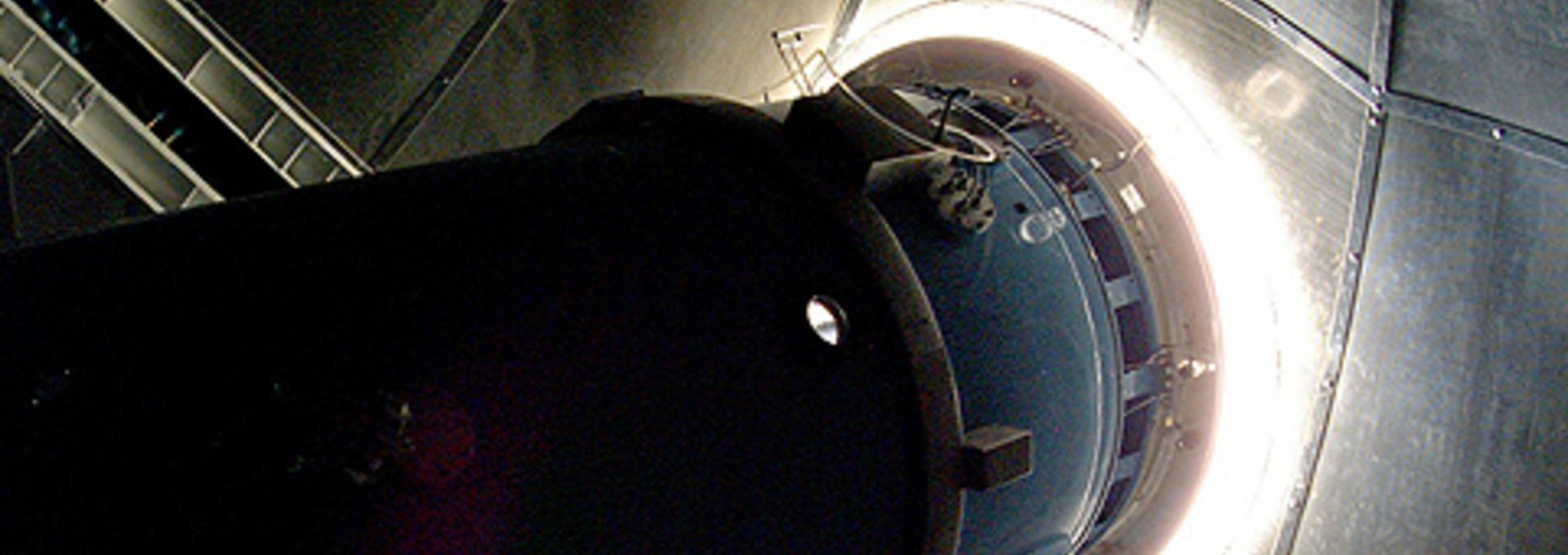Télescope Héliographique pour l'Étude du Magnétisme et de l'Instabilité Solairee


THEMIS is a joint operation from France (CNRS/INSU) and and Italy (INAF) national research agencies. It is located at Izaña, 2400 m, within the Teide Observatory from the Instituto de Astrofisica de Canarias, on the island of Tenerife. THEMIS stands for "Télescope Héliographique pour l'Etude du Magnétisme et des Instabilités Solaires". It is a 90 cm usefull aperture solar telescope, and currently the third larger in the world. Its specific design allows for high-accuracy spectropolarimetry of the solar surface together with monochromatic high resolution imaging.
The f/16 Ritchey-Chretien telescope includes an alt-az mounting, a helium filled telescope tube, a Stokes polarimeter located at the prime focus. The multi-mode spectrograph, delivers routine vector polarimetry analysis with an accuracy ranging from 10-3 to 10-5 in some configurations. The spectrograph design allows the observation of up to 10 wavelengths simultaneously from 400 to 1100 nm, giving an opportunity to perform 3d inversion of the magnetic fields structure in the solar atmosphere. Themis currently offers 3 complementary observing modes:
- MTR mode for multiline spectropolarimetry
- MSDP mode allowing for multichannel substractive double-pass spectro-imaging with polarimetry
- IPM mode for a very narrow-band imaging with a universal birefringent filter followed by a Fabry-Perot interferometer.
After two decades of giant progress and findings in the internal structure of the Sun, the measurement and understanding of the solar magnetic fields has become the true burning issue at the dawn of the 21st century. There is now a rapidly growing interest for scientific topics like the generation and transport of the magnetic field from the base of the solar convective zone to the corona. Flux tubes existence and behavior, coronal heating, interplanetary magnetic field structure, space meteorology and solar-terrestrial relationships possibly connected to the solar activity cycles are major emerging issues of this 21st century.
From the development of the first instruments in France during the 50's, the solar group from Paris Observatory became an international leader for solar magnetic observations during the 70's. Within this group emerged in 1982 the project of a large solar telescope dedicated to the observation of the solar magnetism. The construction started in 1993 and the first light happened in 1996. The telescope is opened to the international community since 1999.
High resolution magnetic field vectors in filament channels in the photosphere are filled with parasitic polarities like the one shown in the figure (40x20 arcsecs approx). The field topology represented by the blue arrows reveals what at first sight seems to be like a dip in the magnetic line of force. Such a dip would be a place of choice for the accumulation of cool plasma escaping from the filament hanging over the channel 10000 km high. Those structures, called filament feet, would thus be explained by magnetic dips like the one seen by THEMIS and shown in the figure.
Magnetic fields can also be measured directly in prominences through polarimetric measurements in selected spectral lines of He and high control of scattered light in the telescope. THEMIS simultaneously measured the 4 Stokes parameters and in particular the circular polarization of the He D3 line which resulted in a preliminary field strength of 40G, stronger tan Expected.